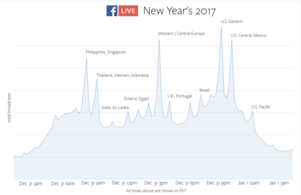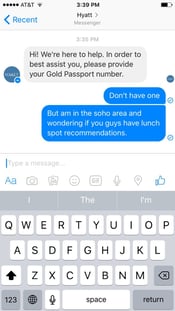7 Predictions for Social Media in 2017 1) Live video content will become even bigger. And just this New Year’s Eve, live streaming on Facebook reached record-breaking numbers around the globe: In addition to Facebook Live and Periscope, Instagram and Twitter launched their versions of live video streaming in November and December 2016, respectively. For example, many brands are using Facebook, Instagram, and Twitter to live stream events. More specifically, many brands are using messaging apps to communicate one-on-one with customers, which is completely changing the way customer service gets done. People come to social media to interact with interesting content, so instead of sharing a photo of a product on Instagram with a “Buy Now” call-to-action, share gift ideas and product trends (24% and 16% of survey respondents relied on social media for these, respectively) and encourage online shopping without directly asking for it. Product demonstration videos on social media. This year, video streaming will represent almost 75% of all internet traffic, and since audiences want more video content, brands should continue experimenting with different formats -- including virtual reality -- to see which audiences respond best to. Snapchat started the ephemeral, or disappearing, visual content sharing trend, and Instagram recently launched a similar disappearing video feature -- but with the ability to share live ephemeral video, too. For this and other reasons, Emanuele predicts that brands will start transitioning from Snapchat to Instagram for sharing Stories (photos and videos that disappear after 24 hours). What are you including in your 2017 social media plan?

It’s the start of another year, which means you’re probably back in the office after vacation, hard at work on your New Year’s resolution. And if you’re a marketer, you may also be fine-tuning your strategic plan for success in 2017.
We have a variety of resources for getting your marketing plan organized for the upcoming year — between the 2017 marketing strategy kit, the social media content calendar, and the blog editorial calendar, we’ve got your content marketing strategy covered.
But before you finalize your social media strategy for the year, it’s important to look at what’s ahead to ensure that you’re allocating your time and efforts appropriately. In this blog post, we’ll dive into what happened in 2016, what we think social media managers should expect in 2017, and how to plan for these changes.
7 Predictions for Social Media in 2017
1) Live video content will become even bigger.
Live video content is on the rise — in fact, 14% of marketers experimented with it in 2016, according to Social Media Examiner, and 43% plan to use interactive video this year, according to new survey data from Wyzowl.
While there are a ton of streaming sites and platforms out there, both Periscope and Facebook Live are among the most popular — and they have the numbers to prove it.
In its 2016 annual recap, Periscope noted that users watched 110 years of live video every day using the app. And just this New Year’s Eve, live streaming on Facebook reached record-breaking numbers around the globe:

In addition to Facebook Live and Periscope, Instagram and Twitter launched their versions of live video streaming in November and December 2016, respectively.
So where should you be planning to focus your live streaming efforts in 2017?
Good question. First and foremost, you’ll want to consider where your audience already spends time on social media — and try to connect with them on those networks.
As for what to broadcast, there are a lot of brands out there that are nailing this strategy across several use cases. For example, many brands are using Facebook, Instagram, and Twitter to live stream events. This approach aims to keep your followers engaged with your brand by bringing an event they otherwise might not be able to attend directly to their screens.
At INBOUND 2016, HubSpot shared Facebook Live interviews with speakers so our followers who couldn’t join us in Boston still had the opportunity to learn from the experts:

Brands can also use live video for customer service by hosting Q&A sessions and product demonstrations. These videos drive engagement because hosts can ask for comments, questions, and feedback from the audience.
Brands can also stream multiple live videos in a series, providing more opportunities for engagement, which Facebook said happens at a rate 10X higher with live videos. Here’s an example of a weekly series from Allure, where hosts demonstrate and review a new type of lipstick and ask the audience for questions and what they want to see in the next installment:

This year, keep an eye out for new features rolling out to the different live streaming platforms to amp up your video strategy. For example, Facebook Live is launching 360-degree capabilities, which would be a neat way to record a crowded event, a beautiful landscape, or a behind-the-scenes tour.
(Read more about successful strategies for Facebook Live in this blog post.)
2) Brands will lean on messaging apps more than ever.
If you’re only thinking about messaging apps such as Facebook Messenger, WhatsApp, and WeChat as alternatives to traditional text messaging, think again — messaging apps are used by 4 billion users worldwide, and there’s tremendous opportunity for brands to leverage this presence.
More specifically, many brands are using messaging apps to communicate one-on-one with customers, which is completely changing the way customer service gets done. These apps provide a faster and easier way for customers to get the assistance they need, rather than being placed on hold or waiting for a returned email. Deploying messaging for customer service is more scalable and cost-effective for businesses, and by providing a better experience for the customer, brands can solve their problems quickly and retain them more easily.
For example, Hyatt uses Facebook Messenger for 24-hour customer service, where guests can make reservations, ask questions, and get recommendations for their trips:

HubSpot Vice President of Marketing, Meghan Keaney Anderson, predicts that messaging apps will eventually become a part of every online interaction. “Maybe we shouldn’t be thinking about messaging in terms of apps at all,” Anderson notes, “but rather as an evolving infrastructure.”
So far, Anderson’s theory is well-supported by the stats: A quarter of all apps that are downloaded are abandoned after just one use — except for messaging apps. In 2017 and beyond, marketers should anticipate less social networking and more messaging for instant, real-time connection with audiences.
COMMENTS